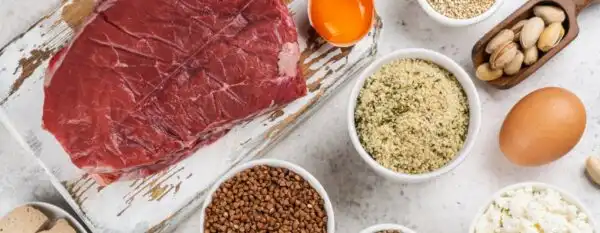What is protein at a molecular level?
There are three macronutrients that power the body: protein, carbohydrates, and fat. Macronutrients are essential, meaning we must obtain them from the diet. Protein makes up the bones, muscles, skin, and hair, and powers many chemical reactions that take place in the body. Protein is made up of 20 different building blocks called amino acids. Some foods contain all 20 amino acids, while others contain only some, but the body puts these dietary amino acids from different protein sources together to create various proteins. It is important to consume enough protein to power the body and allow for these reactions to occur. Hint, hint, you probably already do.

Myths about protein
There are umpteen myths surrounding a protein-rich meal plan and protein diet plans that need to be busted before you understand your ideal protein intake.
- Protein will make me gain muscle – Due to its important role in muscle maintenance, protein powders, high-protein foods, and protein diet plans are often marketed to help us gain muscle. While your body does need more protein than it normally does when you are working out or bodybuilding, eating protein alone will not do anything to increase your muscle mass.
- Eating more protein will help me lose weight. Though adequate consumption of protein helps to keep you fuller longer, focusing on incorporating more protein sources and eating more of this macronutrient alone can lead to an imbalance in your diet.
- Most people are not getting enough protein. Protein deficiency in the United States is pretty rare, since most people eat meat, dairy, eggs, and other animal products. Americans tend to eat 2x their recommended intake of protein per day.
- Vegetarians and vegans cannot get enough protein – This is a very common way of thinking. While animal products contain higher protein per serving, grains, legumes, tofu, and vegetables contain protein, so as long as the individual is creating balanced meals, they can reach their protein goals.
How much protein should I get per day?
The recommended amount of protein needed per day is based on activity level and weight. Each protein diet plan is tailored to the individual based on certain factors. To find out how much you need from your protein sources, start by converting your weight from pounds to kilograms by dividing it by 2.2.
- Ex: 150 lbs/2.2 → 68kg
Next, determine your activity level. For sedentary adults, multiply that number by .8. This will be your goal protein range for the day in grams.
- Sedentary 150 lb individual: 68kg (.8-1) → goal of 55-68g protein per day
- Same individual, weight/endurance training 5x per week: 68kg (1.2-2) → goal of 82-136g protein per day
The most important part of protein intake is making sure you are within the recommended range of intake.
What are the best protein sources?
Animal products will be the foods that contain the highest amounts of protein, making them among the best protein sources.
- 4 ounce serving of sirloin steak will provide about 33 grams of protein.
- 4 ounces of ham will provide 22 grams of protein.
- 4 ounces of salmon have about 30 grams of protein.
Common portion sizes of protein include:
- 4 oz steak → 33 g
- 4 oz fish→ 30g
- 4 oz chicken or turkey→ 30g
What are some plant-based protein sources?
- One cup of cooked lentils provides about 18 grams of protein
- ½ cup of cooked tofu contains 10 grams of protein
Other sources of plant-based proteins include:
- One cup chickpeas → 15g
- One cup cooked quinoa → 11g
- 2 tbsp nut butters → 7g
If you want to make sure that your diet is meeting your health needs, or would like to create a protein diet plan tailored for you, you can consult with one of our registered dietitians.
Written by Marissa Gusmao
Edited by Alexander Franz
Reviewed by Morgan Murdock, RD.














